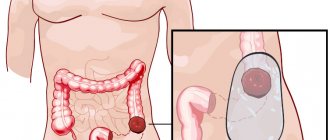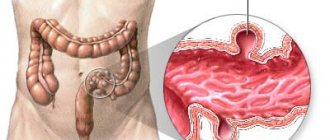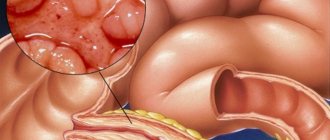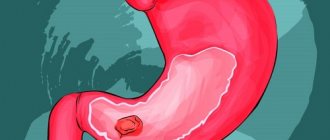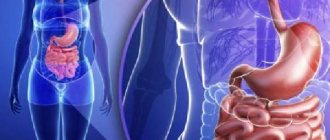The term dysplasia generally refers to pathological processes characterized by the replacement of one type of tissue with another. All this occurs as a result of mutation processes in cellular elements. The stomach is not an exception organ for this pathology.
Gastric dysplasia is the replacement of any of the tissue layers with a pathological, non-characteristic type, most often connective tissue fibers.
As the process progresses, it moves from localized to generalized, that is, an increasing volume and thickness of the stomach is affected. In this case, a change and disruption of the functions inherent in the organ occurs. Secretory and digestive activity is disrupted.
What happens at the cellular level
The dysplastic process affects all cellular structures, changing their histological features. In this case, some of the cells die, and some mutate, turning into foreign atypical cells. All this is followed by oncological transformations.
The proliferation phase actively increases and the differentiation stage decreases. That is, new cells that originate from old damaged ones will already carry foreign information and material in their composition and can become very dangerous for the body.
The process in most cases begins with dysplasia of the gastric epithelium. In this case, different types of epithelial fibers turn into connective tissue. The glandular epithelium is most susceptible to negative effects.
The gastric glands, parietal and parietal islets, which are responsible for the production and secretion of hydrochloric acid, pepsin, and digestive enzymes, change. As it progresses, dysplasia of the gastric mucosa occurs.
This is a more serious process, because severe chronic pathologies may appear against this background, such as gastric ulcers, chronic atrophic gastritis, precancerous conditions and cancer.
Many scientists identify dysplastic changes as a precancerous condition, which sooner or later turns into severe forms.
What causes the disease
There are two main groups of reasons for the formation of the process:
- Exogenous or external factors. These are the conditions that act on the organ from the external environment, causing structural and functional changes.
- Endogenous or internal factors. Chronic pathological processes and diseases lead to them.
What refers to exogenous causes:
- Irrational food intake. This factor includes quick snacks, dry food, overeating and passing, eating food once a day.
- Consumption of low-quality harmful products. This criterion includes everything fried, fatty, too salty, spicy, sour, fast food, smoked, canned. The most dysplasia-provoking product is vinegar!
- Bad habits are in second place after vinegar. Scientists have proven that smoking tobacco in 99% of cases causes irreversible dysplasia of internal organs. The gastrointestinal tract is especially affected. It is safe to say that dysplasia is a disease of smokers. Alcohol has a very detrimental effect, especially its systematic use. Alcohols change the morphological and genetic structure of cells, leading to their death or changes in properties.
- Vitamin deficiencies and hypovitaminosis can directly provoke the disease. Vitamins have a beneficial effect on our body, improve immunity, and are important antioxidants. If they are deficient, all these functions are reduced, and the organ becomes more vulnerable to adverse effects.
- Impact of negative environmental factors.
- Hereditary predisposition. Doctors have noticed a pattern that dyspalasia often occurs among generations of the same family and is inherited. This means that this pathology has a dominant gene set.
- Long-term use of medications. These include: hormones, oral contraceptives, non-steroidal anti-inflammatory drugs, cardiac glycosides, cytostatics and others.
- Exposure to radiation. In this case, the cellular composition can mutate immediately or delayed.
- Poisoning and burns of the mucous membranes with chemicals, acids and alkalis.
What internal factors can influence:
- Immunodeficiency states. These include both primary congenital immunodeficiencies and acquired immunodeficiency syndrome AIDS.
- Genetic mutations at the cellular level.
- Chronic endocrine diseases: diabetes mellitus, pancreatitis, thyrotoxicosis, hypothyroidism and others.
- Increased secretion of hydrochloric acid by the stomach. Its excess has an aggressive effect on the organ wall.
- Infectious lesions: Helicobacter pylori infection and its carriage, dysentery, salmonellosis, enterovirus infection, etc. Fungal infections in the form of candidiasis.
- Dysbiosis and dysbacteriosis of the gastrointestinal tract.
Disease severity
All over the world it is customary to distinguish three main degrees of the dysplastic process. This gradation also applies to the stomach. The degrees reflect both the clinical and morphological picture of the disease, indicating at what level and volume of pathological changes. Further treatment and prognosis of the disease will depend on this.
- Dysplasia 1st degree
It is characterized by minimal pathological and morphological processes in the composition of cellular structures. In this case, an imperceptible swelling of the cell occurs, increasing its volume.
The internal organelles are slightly damaged. The cell divides by mitosis. Daughter cells may be without pathology. Clinically, this is manifested by focal lesions of the mucous membrane, acute gastritis, without obvious changes in secretory function.
- Dyspalasia 2nd degree
At the cellular level, more serious changes occur, even irreversible ones. The cell nucleus swells greatly and occupies more than half of the cytoplasm.
Upon morphological examination under a microscope, it is brightly colored and chromatin threads are clearly visible. The functions of the organ change greatly, irreversible dystrophic, atrophic and metaplastic processes appear.
The glands of the stomach suffer and do not fully secrete the secretion necessary for digestion. Clinically detected in the form of ulcerative changes, gastroesophageal reflux disease. The entire mucous layer, more than half of the basement membrane, is affected.
- Dysplasia 3rd degree
True precancer. The basement membrane is affected. The functions of the stomach are affected to a greater extent. The cell nucleus takes on an atypical appearance. The cells are recognized as foreign.
Transformation of cellular organelles occurs. Gastric secretion is turned off, hydrochloric acid is not released. It occurs like a severe form of atrophic gastritis.
All gastric tissue is replaced by connective tissue. Treatment for grade 3 gastric dysplasia is surgical or in the form of replacement therapy.
Treatment
Treatment of gastric dysplasia is carried out using conservative methods. Surgical intervention is required only in cases where medication does not give the desired result or is inappropriate.
The pharmacological part of the treatment includes the following drugs:
- antibiotics;
- bismuth preparations;
- proton pump inhibitors;
- antacids;
- prebiotics;
- antioxidants;
- metabolic;
- vitamin and mineral complexes.
Additionally, a diet must be prescribed. The principle of nutrition and the list of prohibited and permitted foods are determined by the doctor on an individual basis.
The prognosis for grades 1-2 is favorable. The third degree requires thorough and long-term treatment, and there is a high risk of developing an oncological process.
Symptoms and treatment of gastric dysplasia
Dysplastic changes are a very complex and lengthy process. Five or decades may pass from one stage to another. Progressive dynamics are always observed with it.
With early diagnosis and complete correct treatment at an early stage, the disease can become reversible and regress. If this does not happen, then they try to stop the phenomena at the most minimal and easiest stage.
The higher the degree and volume of the area involved in the disease, the higher the risk of developing a malignant tumor. Symptoms in a person appear depending on the severity.
With a mild degree, the patient may not be bothered by anything. Rare discomfort in the stomach and heaviness after eating are noted. Due to the fact that this form of pathology has few signs, it is the most difficult to identify.
With grade 2 dysplasia, more serious signs begin to manifest themselves:
- Periodic or constant pain in the projection of the stomach or upper abdominal cavity. The pain can vary in intensity and may or may not be associated with food intake. Pain syndrome is always accompanied by severity.
- Nausea. It is especially provoked by eating poor quality food. May be accompanied by vomiting.
- Heartburn. Occurs when gastroesophageal reflux disease occurs. If heartburn has become permanent and is not relieved by medications, it is a bad prognostic sign.
- Belching of air or stomach contents.
- Flatulence and bloating.
Grade 3 dysplasia is clinically more severe:
- The secretory activity of the stomach is completely reduced.
- Severe pain syndrome. Patients refuse to eat due to pain, discomfort and bloating.
- Sudden weight loss.
- Symptoms of general weakness, chronic fatigue.
- The occurrence of anemia, folic acid deficiency.
- Against the background of all of the above, dry skin and decreased elasticity appear. It is not an independent sign of gastric dysplasia!
- Dyspeptic disorders of the gastrointestinal tract. Frequent diarrhea, then comes a phase of constipation up to intestinal obstruction.
- Gastrointestinal bleeding. A terrible sign. It manifests itself as vomiting streaked with blood, tarry black stools – melena.
If one of these signs or a combination of them appears, you should immediately consult a doctor for specialized help. The doctor will assess the patient’s condition and prescribe the necessary medical procedures to make a diagnosis and further complete treatment.
An important diagnostic method for detecting dysplasia is endoscopic examination of the stomach - fibrogastroduodenoscopy with targeted biopsy and further morphological assessment under a microscope.
Is intestinal dysplasia dangerous, and how to treat the disease?
A colon tumor develops over several years. This formation is preceded by the appearance of polyps, which are benign tissues in the colon. Some of them can eventually transform into a cancerous tumor, which generally depends on the type of polyp.
Precancerous polyps include the adenomatous type, and inflammatory and hyperplastic formations do not have the ability to degenerate into a malignant tumor, but in some cases they create certain prerequisites.
Another type of precancerous condition is intestinal dysplasia. This name describes the area of the intestinal mucosa where the abnormal type of cells are located.
The main feature of such cells is their predisposition to transform into cancer. Dysplasia is often detected in patients who have inflammatory processes in the intestinal mucosa, with diseases such as Crohn's disease and ulcerative colitis.
Colon polyps and dysplasia
Histological tumors of the intestine are classified into carcinoid, epithelial and non-epithelial. The vast majority are epithelial tumors, divided into adenomatosis and adenoma.
Adenoma, in turn, is divided into tubular, tubulovillous and villous. It is a benign tumor consisting of glandular epithelium. Tubular adenoma has a branching structure, with loose connective tissue located around it.
The surface of the tumor is smooth, the size is small, as a rule, does not exceed a centimeter. A villous tumor is characterized by a lobulated surface and is often similar in appearance to a raspberry.
It has a wide base, and its size can reach 5 cm. Tubulovillous tumor is an intermediate position between the first two types of adenoma.
All types of adenomas are taken into account according to the degree of differentiation and dysplasia (severe, weak or moderate). Severe dysplasia is characterized by gross disturbances in the structure of the villi and glands, with a complete absence of secretion. Goblet cells are often absent or present in single form.
With severe dysplasia, numerous mitoses are observed, often of a pathological nature. Mild dysplasia preserves the structure of the villi and glands, which contain a significant amount of mucous secretion.
With this form, mitoses occur sporadically, and goblet cells are found in reduced numbers. Moderate dysplasia occupies an intermediate position.
With the development of severe dysplasia, areas of glandular proliferation are often observed, due to pronounced signs of atypia, as well as formed solid-type structures. There are no signs of invasion. In medical practice, such lesions are called carcinoma or non-invasive cancer.
Epithelial dysplasia, which occurs in a mild or moderate nature, does not apply to carcinomas, while a severe form of dysplasia rightfully provokes non-invasive cancer, which will soon turn into invasive.
Adenomatosis is characterized by numerous adenomas, numbering 100 or more. With this formation, tubular adenomas are more often detected, and the degree of dysplasia varies.
Neuronal intestinal dysplasia in children
Neuronal dysplasia is often detected in children suffering from regular constipation. This form of the disease is characterized by the vicious development of ganglia and nerves in the intestinal submucosa and in the muscular plexus.
Neuronal dysplasia can be congenital, detected in 5% of cases, or developed over the years. With a congenital form of the disease, the child experiences the following symptoms: frequent bloating, diarrhea, bloody stool, and intestinal obstruction may also occur.
The acquired form is accompanied by signs typical of Hirschsprung's disease. To diagnose neural intestinal dysplasia in a child, specialists use a rectal biopsy technique.
Young patients suffering from neural intestinal dysplasia are prescribed a course of drug treatment, including the use of laxatives. Treatment in stationary or semi-stationary conditions involves carrying out cleansing enemas.
In more than 60% of cases, treatment of acquired neural intestinal dysplasia in minors using therapeutic methods gives successful results.
